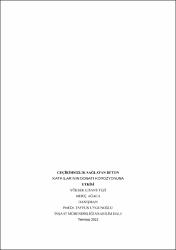Geçirimsizlik sağlayan beton katkılarının donatı korozyonuna etkisi
Abstract
Kullanımı en yaygın yapı malzemesi olan betonda, özellikle son yıllarda yaşanan depremler sonrasında sadece dayanım (yük taşıma kapasitesi) standartlarının yeterli olmadığı görülmüştür. Betonun boşluklu yapısı sebebiyle sıvı veya gaz halde betonun iç yapısına etki eden maddelerin erken yaşlarda betonun basınç dayanımını etkileyecek mertebede bir zarara uğratmasada, ilerleyen yaşlarda betonun servis ömrünü hesaplanan değerden daha düşük seviyelere çekmektedir. Betonarme yapılarda fiziksel, mekanik veya kimyasal etkenlerden dolayı oluşan hasarlar, yapılarda doğrudan veya dolaylı yoldan donatı korozyonunun başlamasına neden olmaktadır. Betonarme yapılarda zamanla meydana gelen korozyon, donatıda kesit kaybı yaşanması, kopma mukavemetinde azalma, beton ve donatı arasındaki aderansın azalması, pas payı tabakasının hasar görmesi sonrasında dökülmesiyle beraber donatının açığa çıkmasıdır.
Korozyon oluşumuna karşı alınabilecek önlemlerden geçirimsiz kimyasal katkılar hakkında çalışma yapılmış olup iki adet yapısal geçirimsiz katkı yine iki adet de yüzeysel geçirimsiz katkı kullanılmıştır. Üretilen 9 seri numuneye basınç dayanımı, hızlı klor geçirimliği, elektiriksel iletkenlik, hızlandırılmış korozyon deneyleri ve mineralojik ve morfolojik analizleri yapılmıştır. Çalışma sonucunda üretilen tüm serilerde boşluk oranının azaldığı görülmüştür. Su itici özellikli geçirimsiz katkının beton dayanımını bir miktar düşürdüğü gözlenmiştir. Bitüm esaslı yüzeysel geçirimsiz katkılarda en düşük kılcallık katsayı değeri saptanmıştır. Korozyona uğrama riski yapısal katkılarda %2 kullanımda düşük, çimento esaslı yüzeysel katkılarda orta ve bitüm esaslı katkılarda ihmal edilebilir düzeyde olduğu elde edilmiştir. Yüzeysel ve bitüm esaslı katkıların geçirimsiz beton uygulamalarında daha olumlu sonuçlar elde edilmiştir. After the earthquakes in the recent years, it has been observed that, bearing capacity (load carrying capacity) standards of concrete, most commonly used construction material, are not sufficent. Even though the liquid or gaseous substances effecting the internal structure of concrete due to it's cellular structure don't damage the concrete's compressive strength at an early age, those substances causes the service life of concrete be shorter than previously calculated. Damages due to physical, mechanical and chemcial parameters in reinforced concrete structures causes the emergence of reinforcement corrosion implicitly or explicitly. Corrosion that occurs in concrete structures in time, is the revelation of reinforcement as a result of the loss of cross section in reinforcement, decrease in tensile strength of reinforcement, decrease in adherence between concrete and reinforcement, impairment of concrete cover and spalling of concrete immediately afterwards. After the study of impermeable admixtures which can be used as a measure to corrosion, two pieces of structural impermeable admixtures and two pieces of superficial impermeable admixtures were adopted. Compressive strength test, rapid chlorine permeability test, electrical conductivity test and accelerated corrosion test and mineralogical and morphological analyses were performed on 9 series of samples. At the end of the study, a decrease in voids ratio in all series was observed. Minimum capillarity coefficent value in bitumen based superficial admixtures was determined. It was obtained that the risk of corrosion was %2 lower in structural admixtures and was on avarage in cement based superficial admixtures and was on a negligible level in bitumen based admixtures. More favourable results were obtained in water impermeable concrete applications of superficial and bitumen based admixtures.
Collections
- Yüksek Lisans Tezleri [890]



















